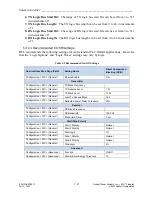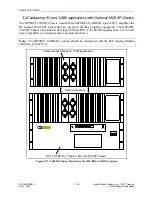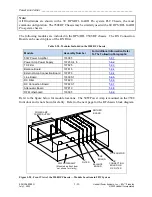
Power Line Carrier ____________________________________________________________________
RF-MCGARDPRO
Hubbell Power Systems, Inc.
–
RFL™
Products
July 1, 2022
©2022 Hubbell Incorporated
5-39
Verifying/Adjusting the Transmit Output Power
The PLC amplifier output power level is factory-set for +30dBm (1W) and +40dBm (10W) into
a 50-ohm impedance. This procedure describes how to verify the transmit output power, and
how to adjust the potentiometer (if required).
1.
Connect the TX port of the PLC to a 50-ohm load.
2.
Measure the transmit output level using an FSVM across the “PA-OUT” (red and
black) test points on the power amplifier module.
3.
Key the transmitter at 10W using the keying inputs or the input test pages (See
4.
M40dBm (10W at 50-ohm) on the FSVM. If the reading is not +40dBm,
adjust the potentiometer R8 on the rear of the amplifier module to a40dBm
(22.26Vrms).
The procedure is complete. The transmitter levels are now verified / adjusted for 1W and/or
10W.
Transmit Fail Adjustment
The PLC amplifier output transmit fail (“TX Fail”) level is factory-set for +28.5dBm into a 50-
ohm impedance. This is typically sufficient for most applications. The TX Fail alarm will go
active if the transmitter output fails below this level. If a different TX Fail level is desired, this
procedure describes how to verify/adjust the TX Fail level.
1.
Connect the FSVM to the PA OUT Test Points on the Analog Module and tune the
FSVM for the TX frequency.
2.
Send Guard (In FSK) or Block (On/Off) at 1W (30dBm).
3.
Adjust R8 on the Power Amplifier until the desired TX Fail Threshold is shown on
the FSVM.
Note:
RFL recommends setting the threshold to 1.5dB below the Guard or Block Signal
level (28.5dBm).
4.
Adjust the TX Fail Threshold pot (R19) of the Power Amplifier until the TX Fail
Output turns on.
5.
Adjust the Gain pot (R8) on the Power Amplifier until the nominal TX level is
shown on the FSVM.
6.
Confirm TX Fail Output is OFF.
Hybrid Tuning Procedure (If Equipped)
The PLC internal skewed hybrid is factory-set for a 50-ohm impedance. So long as the
termination impedance is 50-ohm, no adjustment should be necessary. This procedure describes
how to verify the skewed hybrid operation, and how to make adjustments (if required). The
purpose of tuning the PLC internal skewed hybrid is to match the transmit impedance to the line
tuner impedance, to minimize reflected power. The skewed hybrid also provides isolation
between the TX and RX signals, while coupling the transmitter to the line with minimal loss.






























